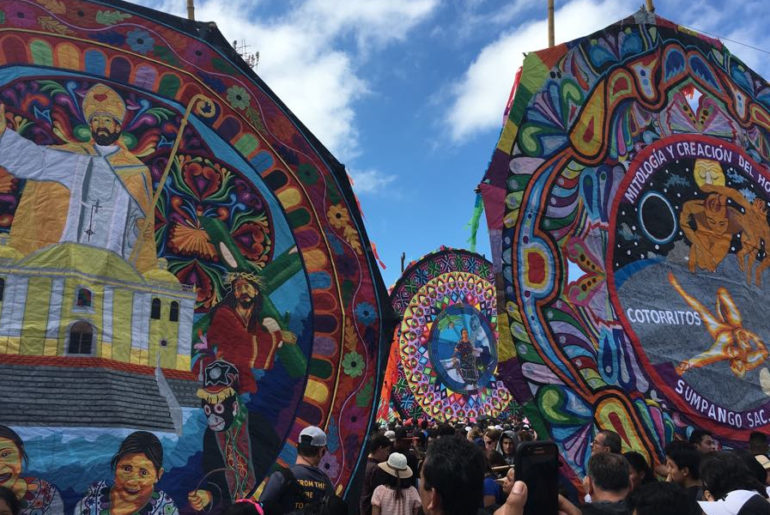QUETZALTENANGO – For children and spirited adults in the US, next Thursday, October 31 is the big holiday of the season; Halloween. The last day of the month is filled with dressing up, trick-or-treating, carving pumpkins, parties, and other sugar-filled traditions. However, in other countries and in Central America, the big holiday of the season is not Thursday, but Friday November 1 – Dia de Todos los Santos, or “All Saints’ Day” in English. The holiday is a time to think about those who have passed, and to visit cemeteries to be near deceased friends and relatives.
Not all cultures that celebrate Dia de Todos Santos have the same traditions. Each country brings its own customs to the holiday. In Guatemala, there are three unique practices that separate the Guatemalan version from its close relatives; Fiambre, Carrera de Cintas, and the Festival de Barriletes Gigantes. We interviewed Kristian Omar Velasquez, a tour guide and language school coordinator from Quetzaltenango, Guatemala to gain insight into these November 1 traditions. Velasquez explained each tradition to Revolution English:
La celebración en Quetzaltenango empieza desde las 4 am donde las diferentes familias van al cementerio para llevar flores, candales, agua, (comida, y bebidas depends las tradiciones) también algunas personas les llevan música.
The celebration in Quetzaltenango starts at 4 am, when different families go to the cemetery to bring flowers, candles, water, (food and drinks too, depending on their tradition), and some people bring their relatives music.
Fiambre
Un plato típico que surgió entre 1970 y 1980 donde tiene origenes de Europa pero se vuelve un plato tradicional de Guatemala donde se como específicamente para esta fecha. Es un plato de diferentes verduras, tiene una capa de diferentes carnes (embutidos) dependiendo del lugar le agregan pescado o camarones, hay dos tipos está el rojo y el blanco.
A typical dish that emerged between 1970 and 1980, with origins from Europe, but became a traditional Guatemalan dish that is eaten specifically on this day. It is a plate of vegetables that has a layer of different meats (sausages) and, depending on the place, they add fish or shrimp. There are two types of Fiambre; red and white.
‘Fiambre’ literally translates to ‘cold cuts’ or ‘cold foods’ and is a Guatemalan traditional “salad” dish. Fiambre combines ingredients from the pre-Hispanic time in Guatemala with other foods that the Spanish introduced; sausages, meats, cheeses, olives, and fish. There are a few theories about how this dish came about, including one suggesting that after an earthquake in the city of Santiago de los Caballeros in Guatemala, there was a food shortage, so women in the town made a dish combining whatever types of food were available.
Festival de los barriletes (Sumpango)
En este lugar es un festival donde con los barriletes gigantes donde la historia dice que si un niño está en el cementerio con el barrilete y entre más alto está el espíritu de la persona llega más cerca del cielo es una de la tradiciones que todavía se practica.
In [Sumpango], there is a festival with giant kites. The story goes that if a child is in the cemetery with a kite, then the spirits are closer. It is a tradition that is still practiced.
This giant kite festival draws huge crowds every year on November 1 to a soccer field next to a cemetery in Sumpango, Sacatepequez. Over 100 groups hand-make giant kites ranging from 6 to 18 meters, every year. The beautiful and intricate kites are made from pieces of colorful paper.
Festival de la carreta de caballos (Todos Santos)
“En este lugar está la carrera de caballos donde no es permitido tomar licor todo el año excepto este dia, donde todas las personas toman. Y también hacen la carrera (borrachos) algo peligroso no? También dicen que en la carrera tiene que morir un persona para que el festival sea bueno hay dos carreras en este dia.”
In [the town of Todos Santos] where the yearly horse race is, it is illegal to drink liquor all year except on this day, when everyone drinks. They also have a (drunk) horse race — pretty dangerous, right? They say that for the festival to be good, someone has to die during the race. There are two races on this day.
One of the more controversial November 1 traditions is called “la Carrera de Cintas.” It takes place each year in the town of Todos Santos Cuchumatan, a little town in the Cuchumatanes mountain range in the department of Huehuetenango, Guatemala. Although it is called a ‘race’, there is no clear winner. Riders charge down the roads in the town at high speeds, wearing the traditional clothes of Todos Santos (a hat with feathers, colorful scarves, and striped pants), carrying a chicken– and the riders are drunk.
One theory of the origin of this insane horse race is that a group of indigenous people once stole horses to escape the Spanish. Another theory is that it is a form of sacrifice to enrich the soul of the land.

